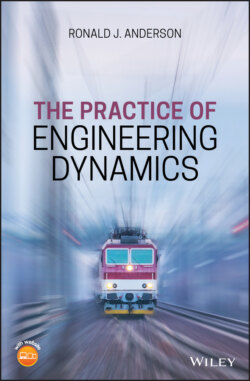Читать книгу The Practice of Engineering Dynamics - Ronald J. Anderson - Страница 19
1.6 Absolute Angular Velocity and Acceleration
ОглавлениеWhen working with three dimensional dynamic systems it is important to have an expression for the absolute angular velocity vector for a rigid body in order to be able to write an expression for its angular momentum vector. The angular momentum is required for moment balances.
Relative angular velocity vectors can be added together in the same way that relative velocity vectors were in Section 1.5. That is, having established the angular velocity of one body in a chain of bodies with respect to a stationary body (i.e. the absolute angular velocity of the body), we simply go through the chain adding the relative angular velocity of neighboring bodies as we pass through the joints connecting them.
For example, the absolute angular velocity of body in Figure 1.5 can be determined as follows,
where the joint at constrains to rotate about a vertical axis relative to the ground, so that,
is the absolute angular velocity of . The joint at constrains to rotate about the axis of with an angular velocity that is relative to giving,
Substituting Equations 1.38 and 1.39 into Equation 1.37 gives the absolute angular velocity of
(1.40)
The absolute angular acceleration of is, by definition, the time rate of change of the absolute angular velocity vector of . In this example we note that the angular velocity vector is expressed in a rotating coordinate system so that there will be both a rate of change of magnitude and a rate of change of direction. The coordinate system has angular velocity . Using the symbol for angular acceleration we can write,
(1.41)
which becomes, upon differentiation,
The final result, after performing the cross‐multiplication in Equation 1.42, is that the absolute angular acceleration of is,
(1.43)
